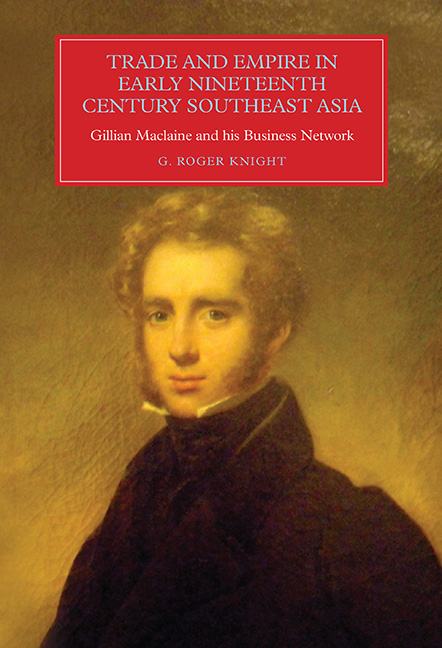 Trade and Empire in Early Nineteenth-Century Southeast Asia
Trade and Empire in Early Nineteenth-Century Southeast Asia Published online by Cambridge University Press: 17 June 2021
Do not be under any apprehensions that we acted rashly or, as the homely proverb has it, ‘quarreled with our bread an butter’. On mature reflection I see no cause to regret the step we have taken, though I do not know whether McIntyre will receive our intimation to quit in the spirit of kindness. I hope he may, because it is not my wish that our departure should give rise to any angry feeling or disagreeable bickering.
The story so far has concerned a young ‘Scotch adventurer’, as he styled himself, arriving first in London and subsequently in Dutch-controlled Java in search of a financial ‘independency’ that would compensate for the lack of material resources of the Highland gentry family into which he was born. In London, he had been no more than a clerk (albeit it a privileged one, since his employers were also closely connected socially with his own kith and kin) in an East India house in the City. Java, where he had arrived in that house's employ in 1820, seemed to offer altogether better possibilities. Breaking with the London house and the trajectory of subordinate employment that they had envisaged for him, he set up as a coffee-planter in the island's interior, using a minute amount of capital provided (however unwittingly) by his maternal uncle.
Within less than two years of his arriving in Batavia, however, Maclaine's plantation, and the commercial ventures associated with it, had already reached a sufficiently parlous state to force him to re-connect with his erstwhile London employers and their Calcutta associates on terms that they dictated. Meanwhile, in Java itself, and as we saw in the previous chapter, his stake in the coffee ‘industry’ was threatened on a number of fronts by the Dutch colonial government's suppression of the lease-hold system on the basis of which his plantations had been established, and by the outbreak two years later in 1825 of a major insurrection against the Dutch in the area of south central Java where his operations were located.
To save this book to your Kindle, first ensure [email protected] is added to your Approved Personal Document E-mail List under your Personal Document Settings on the Manage Your Content and Devices page of your Amazon account. Then enter the ‘name’ part of your Kindle email address below. Find out more about saving to your Kindle.
Note you can select to save to either the @free.kindle.com or @kindle.com variations. ‘@free.kindle.com’ emails are free but can only be saved to your device when it is connected to wi-fi. ‘@kindle.com’ emails can be delivered even when you are not connected to wi-fi, but note that service fees apply.
Find out more about the Kindle Personal Document Service.
To save content items to your account, please confirm that you agree to abide by our usage policies. If this is the first time you use this feature, you will be asked to authorise Cambridge Core to connect with your account. Find out more about saving content to Dropbox.
To save content items to your account, please confirm that you agree to abide by our usage policies. If this is the first time you use this feature, you will be asked to authorise Cambridge Core to connect with your account. Find out more about saving content to Google Drive.